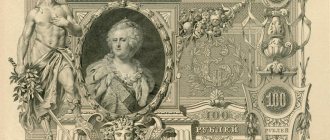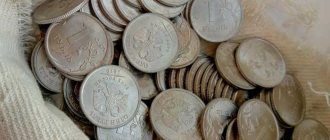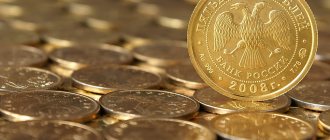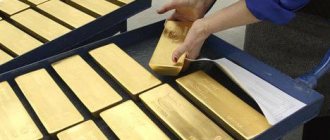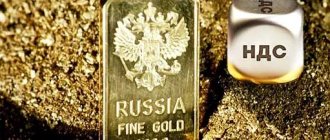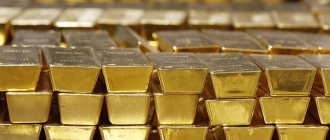In light of recent events in the world, many Russians are concerned about the security of the national currency, since the level of prices for basic goods and services depends on this. Heated debates between economists and politicians in the media do not add optimism. There are many myths circulating about how the Russian ruble is backed, and whether it needs to be backed by gold or not. Understanding why the ruble is becoming more expensive or cheaper relative to other currencies and why the dollar is still “on horseback” can only be done after careful research.
When and how did the ruble appear?
The Russian ruble appeared as a means of payment a long time ago. Back in the 13th century. But then it was more of a measure of weight than a coin. The thing is that hryvnia, which were silver ingots, were used as the national currency of Ancient Rus'. The required amount of silver was cut off, and so the ruble appeared.
It acquired the form of coins during the reign of Peter the Great, when a new, more advanced stamping apparatus was imported. The coins were printed by the Treasury. On one side the denomination was indicated, on the other - the profile of the emperor. The coins were silver.
The first paper rubles
Banknotes, that is, Russian paper rubles backed by gold and silver, appeared in the country during the time of Catherine 2. But paper money did not inspire confidence. The rulers of that time had little understanding of how to further support the ruble, given that there was not enough gold and silver. Often a situation arose when salaries were paid in banknotes, and taxes were required to be paid in silver. This led to peasant unrest and riots.
Along with paper and silver rubles, gold rubles were issued, which were used both within the country and abroad. The leadership of the Russian Empire was forced to use them when conducting international payments. The fact is that after 1860, silver fell greatly in price. New silver mines were found in America, and there was so much of it that practically nothing was given for it. And what backs the ruble, that is, silver, has depreciated.
Securing the ruble in our country
The silver ruble was introduced into circulation by Peter the Great. The very fact that it was minted from silver confirmed its solvency. The paper notes that appeared later were much less trusted and quickly depreciated. An attempt to link the ruble to a precious metal was made in the last third of the 19th century, when gold coins were minted. It was not necessary to use them specifically - they were freely exchanged for ordinary paper money in a 1:1 ratio. from this time until 1917, the ruble was backed by gold.
Naturally, the major political and economic crisis caused by the revolution also broke the established gold security system.
The very fact that the state currency is backed by gold is considered positive, but any currency can become quite stable without a direct link to gold. An example is the euro, which is not only not backed by gold, but is generally not tied to the economy of a single country, but at the same time it is not only completely stable, but also serves as a reserve world currency along with the dollar and is freely convertible into any other currency.
As for the Russian ruble, the main factors in securing it today are the receipt of dollars from the sale of oil and gas abroad. This allows the ruble to be relatively stable. However, the geopolitical situation forces us to return to the question of the need to back the ruble with gold again and again, or to stabilize the Russian currency in another way.
Soviet time
In Soviet times, the ruble was backed by gold and not only gold. What the ruble was backed by was indicated on all Soviet banknotes. And it was indicated on the banknote that it was backed by minerals, industrial enterprises and other assets of the state. Although transactions with foreign currency within the country were very limited, only citizens traveling or working abroad had the right to receive, store and exchange, the ruble was a firmly backed currency.
The first years after the disappearance of the USSR from the political map of the world
After the collapse of the USSR, a stable currency ceased to exist. The Russian ruble is not backed by gold or any other assets. There was a massive sale of people's property in the country, and new money was printed almost uncontrollably. Hyperinflation reigned, the refinancing rate reached a record 200%. Turning off the printing press did not stop the process of economic destruction, and in 1998 a default broke out. As a measure to prevent default, the Government carried out devaluation and redenomination, as a result of which ruble bills and coins acquired their modern appearance.
Despite all the vicissitudes of the fate of the national currency, the debate about what backs the ruble and why it is still not a world currency does not subside. Representatives of the opposition, who constantly lose elections, shout about this especially loudly. “They take gold out of the country, but they bring in unbacked green bills,” they shout, appealing to national pride.
Naturally, without access to the process of international trade, it is difficult for the average person to understand what is currently backing the Russian ruble, and why, even if it is backed with gold, it will still fall in price, and the American dollar will remain king in the international market.
What is money?
Money for market participants (with the exception of currency speculators) is not a commodity simply because it itself is worthless. They are the equivalent of a product. This is especially clearly seen in the example of non-cash payments, when money exists not in the form of pieces of paper or coins, but in a numerical, that is, abstract, form. Therefore, it is not so important in what currency the payments will be made, the main thing is that these banknotes can be used to purchase goods. So it doesn’t matter what the ruble is backed by in Russia, if a country is heavily dependent on imported goods, its currency will always sink.
Money must be recognizable and trusted. This means that all market participants accept them as a means of payment and issue goods in return. Therefore, the currency of the country that produces the most is the world currency. If 90% of countries buy American goods (even if these goods are not made in the USA), then the dollar will be valuable.
Why is gold not needed?
Neither the dollar nor the Russian ruble is backed by gold, because gold is just a metal, a mineral, albeit an expensive one. It, like any asset, is included in the backing of the national currency, but is not of decisive importance. So then what is the ruble and dollar backed by? In a modern economy, the national currency cannot be backed by only one type of product, and even one that is limited in volume. It is provided by all goods and services produced and sold abroad and within the country.
By the way, J.V. Stalin tried to buy seed grain with Soviet gold rubles - they did not accept it, they had to stamp coins with the image of the Tsar (foreigners believed in the imminent collapse of the USSR and the return of Russia to a monarchy). This suggests that gold coins were provided not so much by cost, but by other state assets. They were not so much a product as an equivalent of a product.
Is a return to the gold standard possible?
In the context of sanctions from Western countries and comprehensive pressure on the Russian economy, the idea of abandoning payments in dollars is heard more and more often and more insistently. As an analogue, a currency system based on collateral in the form of yellow metal is proposed.
The introduction of sanctions against Russia is pushing for a discussion of the gold backing of the ruble.
Some actions of the Russian authorities indicate that work in this direction is underway. A weak ruble becomes a threat to the development of the domestic economy, prompting the Central Bank to raise rates. In the short term, the weakening of the ruble will not bring anything good, and the Central Bank of the Russian Federation cannot endlessly raise rates to protect the currency.
The situation is complicated by the sanctions imposed against Russia: the ruble has fallen over the past year against the dollar by more than 30%. The pricing of the ruble in American dollars occurs through foreign exchanges, which also does not strengthen Russia’s position. A currency war threatens serious economic problems, so many experts express support for the option of returning to the gold standard.
Options for creating gold collateral
How can the ruble be pegged to gold? With the Russian economy at 2 trillion. US dollars, external public debt is about 378 billion. Foreign exchange reserves are approximately 429 billion dollars, of which about 45 billion are stored in the form of real precious metal. The budget deficit will be about 1% of GDP in 2015. These conditions suggest that the gold standard can be introduced and successfully used for a long time. The two main conditions for its success will be strict adherence to budget discipline and strict control of the credit sector.
By setting ruble-to-gold conversion rates, the Central Bank will be able to use all its powers to manage currency liquidity. Authorities will no longer be limited to gold buying and selling transactions.
One option could be the issue of coupon bonds, the yield on which will be tied to gold.
Managing the ruble exchange rate under the gold standard will cause some difficulties, but with the competent work of the Central Bank, they can be resolved. Lending growth will have to be limited, otherwise the entire created system will be at risk. The massive conversion of rubles into precious metals can be regulated by withdrawing the currency from circulation.
In general, pegging the ruble to gold is quite possible with the implementation of some economic reforms.
The main threat to the gold backing of the ruble is the central banks in London and New York, which can buy rubles and present them for exchange for the yellow metal. But this possibility can also be limited by introducing special rules.
It is unclear whether the ruble will be backed by gold or other collateral in the near future. The assessment of the consequences for the country's economy is as follows: with the introduction of the gold standard, the ruble should stabilize. This will mean that the increase in the cost of living will slow down markedly, and domestic savings will begin to grow. Ideally, this could lead to political consequences: lower government spending on social security, the establishment of monetary stability and low taxes. All this should create conditions for the creation and further development of a strong production basis for the domestic economy.
Russian goods should only be sold abroad for rubles, then the people will become richer
The status of a world currency does not provide any advantages to the country that issues such currency. As long as a country sells more goods on the world market, its currency will be used as a convenient means of payment by most countries. If American goods are in demand, what is the point of using national currency as a means of payment?
The problem of the security of the Russian ruble is not that domestic goods are sold for dollars, but that the country produces little and sells little goods not only on the domestic market, but also abroad. Dependence on import supplies, and not on the dollar, is the Achilles heel of the Russian economy and the national currency. And whether the ruble is backed by gold is not so important in international trade. Even if (hypothetically) all Russian exports were sold in rubles, they would still have to be exchanged for dollars or some other currencies in order to purchase imported goods.
Trading using Russian rubles will bring nothing but additional costs for commissions on foreign exchange transactions. Moreover, you will have to prove that this is really a secured currency, and not some “African candy wrappers.” After all, most players in the foreign exchange market in the world do not even know about the existence of such a currency as the Russian ruble.
Critical look!
Some experts view the return to the gold standard critically. The history of economics knows positive examples of such government actions, but now is a completely different time. Factors that correspond to the actual state of the economy should be taken into account.
Monetary-type inflation will create uncertainty risks for capital investments and effectively destroy savings, which are vital for financing. Some believe that currency management cannot lead to economic growth.
But the real situation is that if the countries with the largest economies in the world begin the transition to the gold standard, this will mean one thing - the end of the dollar-based currency system. Whether the ruble will be tied to physical gold or not depends on the decision of government authorities. The decision must be made taking into account the size of actual budget expenditures and the presence of long-term obligations.
Such steps by individual countries will lead to a split into two camps: some will use the gold standard, while others will not be able to do this or simply will not want to take this step.
Among those states that can do this and are systematically preparing for the introduction of the gold standard is China. The demand for gold from China in recent years has always been one of the highest; government policy is aimed at accumulating gold reserves and stimulating private investment in the metal. These measures allow the Chinese economy to protect itself from external and internal negative factors.
Chinese authorities often blame American policy for the current situation in the gold market. The US is using its huge gold reserves to suppress other currencies in order to maintain the dollar's leadership. Further strengthening of the Chinese economy may allow the internationalization of the yuan, which will become a competitor to the dollar.
There is another opinion regarding the introduction of the gold standard. Economists say that such a monetary system will not be sustainable, since the supply of money will be controlled not by banking institutions, but by mining companies. The price of gold will constantly change, especially depending on the discovery of new deposits of the precious metal, and inflation will be replaced by deflation.
This development of events is possible, but has several open questions. The rate of gold production is growing much slower than the US Federal Reserve's money printing is increasing. Such actions always lead to inflation and undermine the stability of the monetary system. Under the gold standard, it is simply impossible to make money indefinitely.
Why did the Russian ruble sink after sanctions?
In 2014, the Russian ruble dropped by almost 2 times. The president and the government were blamed for this fall, and the reason was declared to be the annexation of Crimea and covering the costs of the Olympics in Sochi. Although these events had an impact, it was not in the way that is commonly thought.
As a result of the sanctions, Russian enterprises were denied loans from foreign banks. The consequences of the habit of living “on credit” quickly made themselves felt. Companies were forced to hold back foreign currency and buy fewer rubles.
The foreign exchange market is inert, that is, if there are no purchases of currency or the volume of purchases has fallen, the price falls. And the Russian ruble collapsed. The situation was corrected only by “draconian” methods. Since the treasury received less funds from foreign exchange earnings, the budget deficit had to be covered by additional issuance of banknotes.
The existing system in Russia of tying the ruble issue to exports (and not to the dollar, as some argue), although it gives stability to the exchange rate, is a limiting factor. Whether the ruble is backed by gold reserves or not, under the existing system of money emission, it does not matter. Although the gold and foreign exchange fund available in the country and abroad may be a good safety net, it is still better not to lead to another catastrophe so that it needs to be used.
The ruble will strengthen due to rising oil prices and the key rate
Trading in the US dollar began on October 26 on the Moscow Exchange at the level of 69.71-69.75 rubles. The euro fell to 80.88 rubles.
The weighted average dollar to ruble exchange rate with settlements “tomorrow” decreased to 69.5526 rubles, the weighted average exchange rate of the euro with settlements “tomorrow” – to 80.8538 rubles.
Compared to the official rate set by the Bank of Russia on October 26, the dollar fell by 44.05 kopecks, the euro - by 88.8 kopecks.
The Central Bank last week raised the key rate to 7.5% per annum, due to which some large banks noted an increase in foreign currency sales.
The dollar broke through the psychologically important mark of 70 rubles; last Friday there was an increased demand for the currency from individuals; the dollar was in greatest demand, VTB notes.
However, Uralsib and Home Credit do not note any change in demand for currency from the population.
Moscow Credit Bank and Otkritie Bank also do not observe an increase in demand for foreign exchange transactions.
According to the head of the Ministry of Economic Development, Maxim Reshetnikov, the ruble is fundamentally undervalued. “The current exchange rate of the ruble contains all possible fears. The fundamental level of the course is somewhat different. Comparing the current oil price and the ruble exchange rate, you understand perfectly well that this is a non-equilibrium situation,” Reshetnikov said.
Meanwhile, the price of December Brent futures rose on the London ICE Futures exchange by $0.26 (+ 0.3%) to $86.25 per barrel. The day before, Brent rose in price by $0.46 (+ 0.5%) to $85.99 per barrel.
The price of December futures for WTI rose on the New York Mercantile Exchange (NYMEX) by $0.13 (+ 0.16%) to $83.89 per barrel.
“The USD/RUB currency pair fell below 70 rubles/$1 on Monday for the first time since June 2021. The ruble is actively strengthening against the background of high oil prices and tightening monetary policy of the Central Bank. An important factor remains the lack of escalation of tensions in relations with the United States, which reduces sanctions risks.
There are no reasons for the trend to reverse yet. If we rely on important technical milestones, then the area of 68-68.5 rubles/$1 could act as intermediate support from below,” notes BCS Express analyst Igor Galaktionov.
If the price of oil reaches $100 per barrel in winter (as large investment banks predict), then the dollar will drop to 60 rubles, emphasized Georgy Vashchenko, head of the trading operations department on the Russian stock market, Invest.
“The currencies of commodity-based economies continue to strengthen against the backdrop of oil prices... The dollar/ruble pair on Tuesday will try to test the level of 69.5 rubles/$1 with a possible desire to reach the level of 69 rubles/$1.
However... technically the ruble looks overheated, which makes us fear a possible return of the American currency above the level of 70 rubles/$1 in the near future,” notes Egor Zhilnikov, chief analyst of the economic and industry analysis department of Promsvyazbank.
